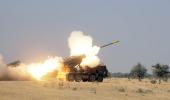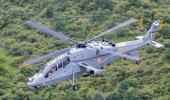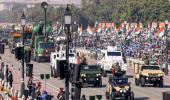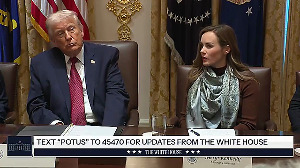India fully utilised its military modernisation budget in 2024-2025 -- the first time in five years -- and signed a record Rs 2 trillion defence contracts.

India must increase its defence modernisation budget -- the outlay for acquiring weapons, systems, and platforms -- nearly two-and-a-half times by the start of the next decade to meet its ambitious defence production targets and advance aatmanirbharta, say experts.
Simultaneously, the share of research and development in total defence expenditure needs to more than double, and the industry must triple the share of such spending in revenue.
With India fully utilising its military modernisation budget in 2024-2025 -- the first time in five years -- and signing a record Rs 2 trillion defence contracts -- twice the figure in FY24 -- experts see the country well positioned to trigger a virtuous cycle in the domestic defence industry.
Speeding up field trials
Rajinder Singh Bhatia, chairman of Kalyani Group's defence business and president of the Society of Indian Defence Manufacturers, underscores that full utilisation of the modernisation budget and record contract signings come at a critical time.
"A key learning from Operation Sindoor is the importance of indigenous equipment in ensuring sovereign control -- from integration into command networks to timely capability upgrades," says Bhatia.
"The government has sent a clear message to the industry: Scale up investments in production capacity and R&D. These developments will help realise the goal," he says.
However, Bhatia points out that efforts under the 'Year of Reforms' initiative to streamline and accelerate the acquisition process must continue on a war footing.
"Reforms to the Defence Acquisition Procedure 2020 are on the anvil and should materialise in the coming months," he adds.
"Steps have been taken to shorten procurement timelines, but field-evaluation trials alone still consume most of the 5-7 years required for acquisition. This requires urgent focus," he explains.
Ramping up infrastructure and using modern technology can enable trials simulating various temperature and altitude thresholds to run simultaneously -- potentially at a single location -- significantly reducing the time taken.
Addressing industry leaders at the Confederation of Indian Industry's annual business summit in New Delhi last month, Defence Secretary Rajesh Kumar Singh noted that the ministry of defence would previously surrender a portion of the modernisation budget due to protracted procurement procedures.
"The process timelines for various steps in the procurement cycle have already been crunched. That should save us 69 weeks overall. It's important, but not enough," the defence secretary stressed.

Capital outlay must multiply
Bhatia welcomes the trimming of the procurement timeline, but says that now, with the focus on aatmanirbharta and domestic capital procurement accounting for the bulk of the defence ministry's total procurement in recent years, modernisation budget utilisation and domestic production are correlated.
An increase in domestic production will likely lead to greater budget utilisation, which in turn will drive further production, creating a positive feedback loop.
Against this backdrop, Bhatia views the nearly 15 per cent growth in annual defence production between FY24 and FY25 as a positive, but stresses that at this rate the country will likely undershoot the ambitious target of Rs 3 trillion by FY29-30, by at least a small margin.
"We are on the right track and need to see the steps currently underway through to their logical conclusion and full implementation to achieve our targets."
India's annual defence production reached a record Rs 1.46 trillion in FY25 -- up almost 15 per cent over the previous high of Rs 1.27 trillion in FY24.
The Budget estimate (BE) for the modernisation of the armed forces grew from Rs 80,959.08 crore to Rs 1.49 trillion between FY20 and FY26 -- an increase of 83.7 per cent, at a compound annual growth rate (CAGR) of 10.67 per cent.
However, the domestic private defence industry had last year estimated that the military modernisation budget would need to grow by at least 20 per cent CAGR over the next five years, starting with the Union Budget for FY25, for India to meet its FY29 annual defence production target.
Industry insiders had also emphasised that this growth would still need to be accompanied by a substantial rise in defence exports to achieve the target.
Earlier this month, the defence secretary told Business Standard that conditions were now aligning for India's defence budget to ideally rise to at least 2.5 per cent of gross domestic product by FY30, up from the present 1.9 per cent.
"Reaching the 2.5 per cent milestone would mark the first step towards a medium-term target of 3 per cent, with capital expenditure on the armed forces increasing to at least 0.8 per cent of GDP from 0.5 per cent at a CAGR of about 20 per cent," the secretary had said.
The armed forces' modernisation outlay of Rs 1.49 trillion forms 21.88 per cent of the MoD's total FY26 allocation of Rs 6.81 trillion.
Laxman Kumar Behera, associate professor at the Special Centre for National Security Studies, Jawaharlal Nehru University, says defence outlay increases must be funnelled towards domestic capital acquisition and R&D to match global military powers.
"As of 2019, the United States, United Kingdom and France, respectively, allocated 28 per cent, 22 per cent, and 24 per cent of their defence budgets to equipment, and the North Atlantic Treaty Organization an average of 23 per cent."
Between FY20 and FY24, actual expenditure on the armed forces' modernisation surpassed the allocation under revised estimates (RE) in three years -- by 0.97 per cent in FY20, 4.06 per cent in FY21, and 0.06 per cent in FY22.
The actuals fell short of the RE in FY23 by 4.37 per cent, and in FY24 by 0.27 per cent. However, a service-wise breakdown offers sharper insight.
Under the capital head in FY21, the Indian Army spent 79 per cent of its RE allocation, the Indian Navy 112 per cent, and the Indian Air Force 106 per cent.
In FY22, the army reached 99 per cent, the navy slightly under 99 per cent, and the IAF slightly above 100 per cent.
FY23 saw the army spending 112 per cent, the navy just under 98 per cent, and the IAF slightly over 83 per cent.
In FY24, the army spent under 86 per cent, the navy over 100 per cent, and the IAF 104 per cent.
Boosting R&D spend
A former defence secretary, who does not wish to be named, emphasises that with enhanced domestic procurement set to underpin India's military modernisation, budget utilisation will depend not only on the defence ministry signing contracts but also on timely industry execution.
"Private firms need to increase capital expenditure on R&D and scaling up production," he says, adding that government and defence public sector undertaking support will remain essential to spur private sector investments.
A report by KPMG India and CII, titled Atmanirbhar, Agrani, and Atulya Bharat 2047: India's Defence Industrial Sector Vision 2047, unveiled at last month's CII summit, highlighted that although India's defence R&D expenditure rose from Rs 14,358 crore in FY16 to Rs 26,817 crore in FY26, its share in the total defence budget declined from 4.64 per cent to 3.93 per cent.
'The share of expenditure on defence R&D in total defence spend has remained abysmal in comparison to leading nations, which have a share of 10-15 per cent,' stressed the report.
The report recommended that India aim to increase its defence R&D budget to at least 10 per cent of total defence expenditure by 2032.
'In addition, the industry should increase its average R&D spend to about three per cent of their revenues from one per cent at present.'
Feature Presentation: Aslam Hunani/Rediff











